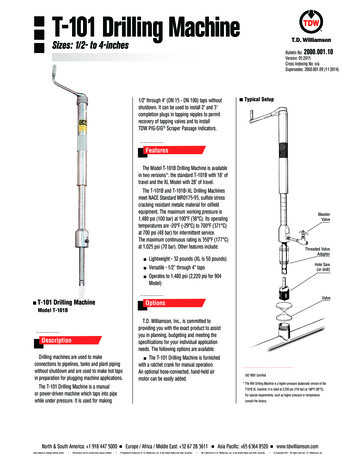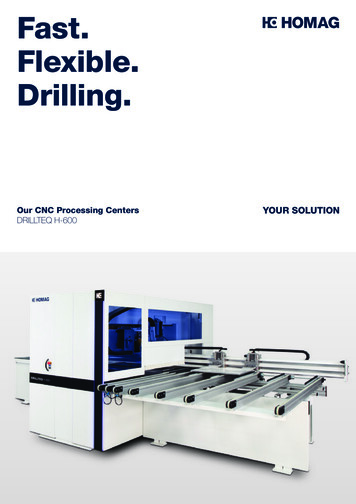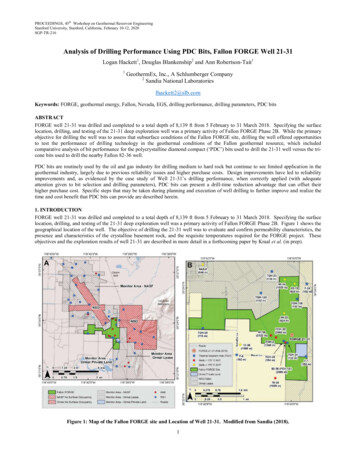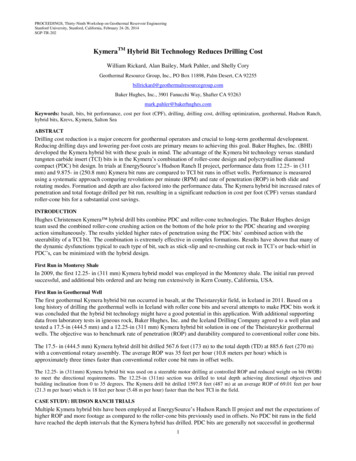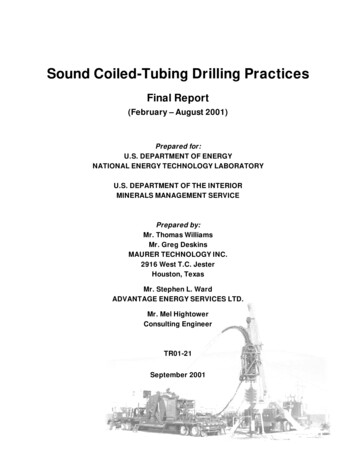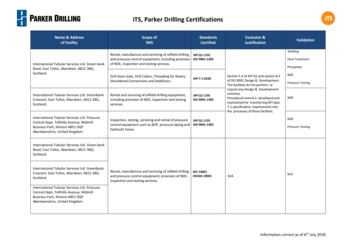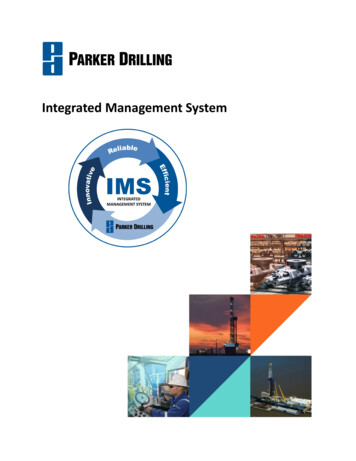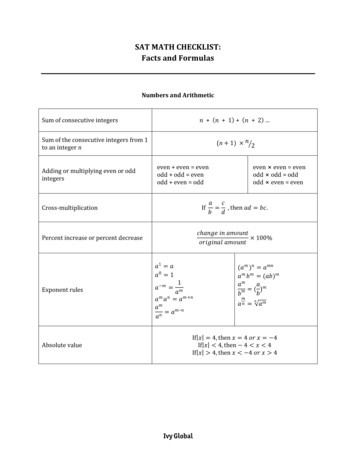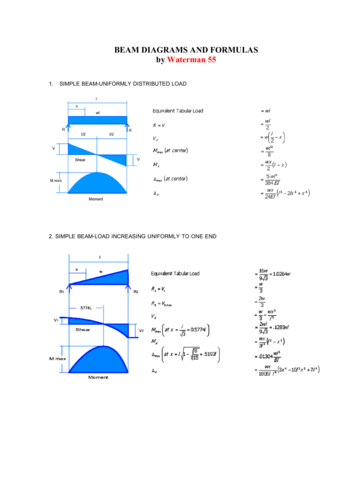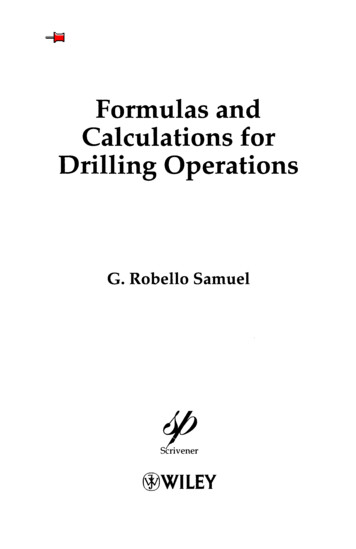
Transcription
Formulas andCalculations forDrilling OperationsG. Robello SamuelScrivenerWILEY
This page intentionally left blank
Formulas and Calculationsfor Drilling Operations
Scrivener Publishing3 Winter Street, Suite 3Salem, MA 01970Scrivener Publishing Collections EditorsJames E. R. Couper Ken DragoonRichard ErdlacRafiq IslamPradip KhaladkarVitthal KulkarniNorman Lieberman Peter MartinW. Kent Muhlbauer Andrew Y. C. NeeJames G. SpeightS. A. SherifPublishers at ScrivenerMartin Scrivener (martin@scrivenerpublishing.com)Phillip Carmical (pcarmical@scrivenerpublishing.com)
Formulas andCalculations forDrilling OperationsG. Robello SamuelScrivenerWILEY
Copyright 2010 by Scrivener Publishing LLC. All rights reserved.Co-published by John Wiley & Sons, Inc. Hoboken, New Jersey, and Scrivener PublishingLLC, Salem, Massachusetts.Published simultaneously in Canada.No part of this publication may be reproduced, stored in a retrieval system, or transmitted inany form or by any means, electronic, mechanical, photocopying, recording, scanning, or otherwise, except as permitted under Section 107 or 108 of the 1976 United States Copyright Act,without either the prior written permission of the Publisher, or authorization through paymentof the appropriate per-copy fee to the Copyright Clearance Center, Inc., 222 Rosewood Drive,Danvers, MA 01923, (978) 750-8400, fax (978) 750-4470, or on the web at www.copyright.com.Requests to the Publisher for permission should be addressed to the Permissions Department,John Wiley & Sons, Inc., Ill River Street, Hoboken, NJ 07030, (201) 748-6011, fax (201) 748-6008,or online at http://www.wiley.com/go/permission.Limit of Liability/Disclaimer of Warranty: While the publisher and author have used theirbest efforts in preparing this book, they make no representations or warranties with respectto the accuracy or completeness of the contents of this book and specifically disclaim anyimplied warranties of merchantability or fitness for a particular purpose. No warranty maybe created or extended by sales representatives or written sales materials. The advice andstrategies contained herein may not be suitable for your situation. You should consult with aprofessional where appropriate. Neither the publisher nor author shall be liable for any lossof profit or any other commercial damages, including but not limited to special, incidental,consequential, or other damages.For general information on our other products and services or for technical support, pleasecontact our Customer Care Department within the United States at (800) 762-2974, outside theUnited States at (317) 572-3993 or fax (317) 572-4002.Wiley also publishes its books in a variety of electronic formats. Some content that appears inprint may not be available in electronic formats. For more information about Wiley products,visit our web site at www.wiley.com.For more information about Scrivener products please visit www.scrivenerpublishing.com.Cover design by Kris Hackerott.Library of Congress Cataloging-in-PublicationISBN 978-0-470-62599-6Printed in the United States of America10 9 8 7 6 5 4 3 2 1Data:
.An elegant Euler's formula wrapped with imaginary andreal numbers resulting in nothing depicts the relationshipbetween the Creator and human intellect.eiK 1 0ToCynthia, Nishanth and Sharon
This page intentionally left blank
ContentsPreface1Basic 21.131.141.151.16CapacitiesDisplacement1.2.1 Displacement of the Pipe Based onthe Thickness of the PipeBuoyancy, Buoyed Weight, and BuoyancyEffective WeightModulus of ElasticityPoisson's RatioMinimum Yield StrengthUltimate Tensile StrengthFatigue Endurance LimitTwistComposite MaterialsFriction1.12.1 Coefficient of Friction1.12.2 Types of Friction1.12.3 Friction and Rotational SpeedGauge and Absolute Pressures1.13.1 Hydrostatic Pressure1.13.2 Mud Gradient1.13.3 Measurement of PressureTemperatureHorsepowerFlow Velocityvn
viii2CONTENTSRig 65657587273762.52.62.72.82.92.102.11Overall Efficiency of EnginesEnergy TransferBlocks and Drilling LineDerrick Load2.4.1 Block Efficiency Factor2.4.2 Block Line StrengthTon-Miles (TM) Calculations2.5.1 Drilling Ton-Miles Calculations2.5.2 Coring Ton-Miles Calculations2.5.3 Casing Ton-Miles CalculationsCrown Block CapacityLine Pull Efficiency FactorRotary PowerMud Pumps2.9.1 Volumetric Efficiency2.9.2 Pump FactorEnergy TransferOffshore Vessels2.11.1 Environmental Forces2.11.2 Riser AngleWell Path Design3.1Average Curvature - Average DoglegSeverity (DLS)3.2 Vertical and Horizontal Curvatures3.3 Borehole Curvature3.3.1 Borehole Radius of Curvature3.4 Bending Angle3.5 Tool Face Angle3.6 Borehole Torsion3.6.1 Borehole Torsion - CylindricalHelical Method3.7 Wellpath Length Calculations3.7.1 Wellpath Trajectory Calculations fromSurvey Data3.7.1.1 Minimum Curvature Method3.7.1.2 Radius of Curvature Method79798080818282868687888889
CONTENTS3.83.93.103.113.123.133.143.7.2 Natural Curve Method3.7.3 Constant Tool Face Angle MethodTypes Of DesignsTool Face Angle ChangeHorizontal DisplacementTortuosity3.11.1 Absolute and Relative Tortuosity3.11.2 Sine Wave Method3.11.3 Helical Method3.11.4 Random Inclination Azimuth Method3.11.5 Random Inclination DependentAzimuth MethodWell Profile EnergyMagnetic Reference and InterferenceWellbore Trajectory 7142145147149150152152152153Equivalent Mud WeightMud WeightingCommon Weighting MaterialsDiluting MudBase Fluid - Water-Oil RatiosFluid LossAcidity-AlkalinityMarsh FunnelMud RheologyPlastic Viscosity, Yield Point and Zero-Sec-Gel4.10.1 Bingham Plastic Model4.10.2 Shear Stress and Shear Rate4.10.3 Power LawHydraulics1595.15.25.3159160161161162Equivalent Mud WeightEquivalent Circulating DensityHydraulics: Basic Calculations5.3.1 Critical Velocity5.3.2 Pump Calculations
xCONTENTS5.45.55.65.75.85.96Bit Hydraulics5.4.1 Basic Calculations5.4.2 Optimization Calculations5.4.2.1 Limitation 1 - Available PumpHorsepower5.4.2.2 Limitation 2 - SurfaceOperating PressureBingham Plastic Model5.5.1 Reynolds NumberPower Law ModelGel Breaking PressureHole Cleaning - Cuttings TransportTransport Velocity165165167168168177177183196197198Tubular 9209210211213215215217218218Drill Collar LengthBending Stress Ratio (BSR)Pipe Wall ThicknessResonant FrequencyTensionsDrag ForceSide Force CalculationTorque and Makeup TorqueBuckling6.9.1 Buckling Criteria6.10 Maximum Permissible Dogleg6.11 Length Change Calculations6.11.1 Stretch Due to Axial Load6.11.2 Stretch Due to the Pressure Effect(Ballooning)6.11.3 Stretch Due to Buckling6.11.4 Stretch Due to Temperature6.12 Stresses6.12.1 Radial Stress6.12.2 Hoop Stress (Tangential orCircumferential Stress)6.12.3 Axial Stress6.12.4 Bending Stress with Hole Curvature218219220221221222223224
39239241245247Drilling 7.57.67.77.87.97.107.118Bending Stress with Hole Curvature,Pipe Curvature, and Tensile Force6.12.6 Torsional or Twisting Shear Stress6.12.7 Transverse Shear Stress6.12.8 von Mises Stress6.12.9 Stress RatioFatigue RatioBending Stress Magnification Factor6.14.1 BSMF for Tensile Force6.14.2 BSMF for Compressive ForceSlip CrushingCumulative Fatigue CalculationxiStretch CalculationsBackoff CalculationsOverpull/Slack-Off CalculationsMotor Calculations7.4.1 Type I Motor7.4.2 Type II Motor7.4.3 Type III Motor7.4.4 Type IV MotorStabilizer Calculations7.5.1 Stabilizer Jamming Angle7.5.2 Alignment Angle of Stabilizerswith the WellborePercussion HammerPositive Displacement Motor (PDM)Rotor Nozzle SizingDownhole TurbineJar Calculations7.10.1 Force Calculations for up Jars7.10.2 Force Calculations For Down JarsSpecific Energy266270271274276279279279282Pore Pressure and Fracture Gradient2878.1287287Formation Pressure8.1.1 The Hubert and Willis Method
xiiCONTENTS.298.1.2 Matthews and Kelly's Correlation8.1.3 Eaton's Method8.1.4 Christman's MethodLeak-off PressureWell Control9.19.29.39.49.59.69.79.89.9Kill Mud WeightThe Length and Density of the Kick9.2.1 Type of Kick9.2.2 Kick Classification9.2.3 Kick ToleranceHydrostatic Pressure due to the Gas ColumnLeak-off PressureMaximum Allowable Annular SurfacePressure (MAASP)AccumulatorsDriller's Method Operational ProcedureKill MethodsThe Riser Margin10 Drilling Problems10.110.2Stuck Point CalculationsDifferential Sticking Force10.2.1 Method 110.2.2 Method 210.2.3 Method 310.3 Spotting Fluid Requirements10.4 Loss Circulation10.5 Increased ECD Due to Cuttings10.6 Mud Weight Increase Due to Cuttings10.7 Hole Cleaning - Slip Velocity Calculations10.7.1 The Chien Correlation10.7.2 The Moore Correlation10.7.3 The Walker Mays Correlation10.8 Transport Velocity and Transport Ratio10.9 335335339
CONTENTS11 Cementing11.111.211.311.411.511.611.7Cement Slurry RequirementsYield of CementSlurry DensityHydrostatic Pressure ReductionContact TimeGas Migration PotentialCement Plug12 Well Cost12.112.212.312.4Drilling Costs12.1.1 Cost Per Foot12.1.2 Coring CostsFuture Value (FV)Expected Value (EV)Price Elasticity12.4.1 Ranges of ElasticityAppendix: Useful Conversion FactorsBibliographyIndexAbout the 62362363365371377387
This page intentionally left blank
PrefaceThis book is an introductory exposition for drilling engineers,students, lecturers, teachers, software programmers, testers, andresearchers. The intent is to provide basic equations and formulaswith the calculations for downhole drilling. This book may be atutorial guide for students, to lecturers and teachers it may be asolution manual, and drilling engineers may find that it is a sourcefor solving problems. Software programmers and testers may useit as a guide as they code, unit test, and validate their implementation, and researchers may use it as a source for further development. Of course, it is very difficult to cover all the aspects andareas of drilling, but this book aims to provide an introduction toexploring the vastness and complexity of drilling engineering. Thereaders are advised to refer to the books in the bibliography formore details regarding underlying theory. This book is a companion to my other books, Drilling Engineering, Downhole Drilling Tools,Advanced Drilling Engineering, and the upcoming Applied DrillingEngineering Optimization.I am grateful to the contributors, the publisher, Phil Carmical,and copyeditor Brittyne Jackson and Mohana Sundaram fromExeter Premedia Services. Also, I thank Dr.Joäo Carlos Pläcido andDr.Dali Gao for helping in formulating some problems. I thankthem for their invaluable help. A work of this magnitude with manyequations and numbers is bound to have errors even though painstaking efforts have been taken. Needless to say, I request that thereaders send errors and comments in effort towards the improvement of this book.faßHouston, TexasXV
This page intentionally left blank
1Basic CalculationsThis chapter focuses on different basic calculations such as buoyancy,weight, tension, etc.1.1 CapacitiesCapacities of the pipe, annular capacity, and annular volume can becalculated using the following equations.The linear capacity of the pipe isC, - -bbl/ft,' 808.5(1.1)where A is a cross-sectional area of the inside pipe in square inchesand equals 0.7854 x Dj , and D. is the inside diameter of the pipein inches.Volume capacity isV CI.xLbbl,where L the length of the pipe, ft.1(1.2)
2FORMULAS AND CALCULATIONS FOR DRILLING OPERATIONSAnnular linear capacity against the pipe isC„ - -bbl/ft,'808.5(1.3)where Ag, a cross-sectional area of the annulus in square inches, is0.7854 x ( D 2 - D 2 ) ,(1.4)Do the outside side diameter of the pipe, in., and Dh the diameterof the hole or the inside diameter of the casing against the pipe, in.Annular volume capacity isV C „ x L bbl.1.2(1.5)Displacement1.2.1 Displacement of the Pipe Based on theThickness of the PipeOpen-ended displacement volume of the pipe isV„ fo-D,lJ2) - bbl/ft.808.50.7854Displacement v o l u m e V0 x L bbl.(1.6)(1.7)Close-ended displacement volume of the pipe isV 0.7854 (D, ) bbl/ft.808.5Displacement v o l u m e VcxL bbl.(1.8)(1.9)
BASIC CALCULATIONS3Problem 1.1Calculate the drill pipe capacity, open-end displacement, closedend displacement, annular volume, and total volume for the following condition: 5,000 feet of 5" drill pipe with an inside diameterof 4.276" inside a hole of SVi".Solution:Linear capacity of pipe, using equation 1.1, is '0.7854XD,'808.5 808.50.7854x4.276' 808.5Pipe volume capacity 0.017762 x 5000 88.81 bbl.Open-end displacement of pipe, using equation 1.6, isV 0.7854 ( D 2 - D,J? ) 0.7854 (δ2 - 4.276 2 ) - '- 0.006524 bbl/ft.808.5808.5Close-end displacement of pipe, using equation 1.8 is0.7854 (D, 2 ) 0.7854 (5 2 )Vr - 808.5808.50.024286 bbl/ft.Annular volume, using equation 1.5 isy C 0 x L - x L x ( Dv 2 - D 2 ) x L""'808.5808.5 51808.5x v(s.52- 5 2 )} x 5000 229.5 bbl.Total volume Pipe volume Annular volume 88.81 229.50 318.31 bbl.1.3Buoyancy, Buoyed Weight, and BuoyancyFactor (BF)The calculations are based on one fluid.
4FORMULAS AND CALCULATIONS FOR DRILLING OPERATIONSBuoyancy Weight of material in air., ,x Fluid density.Density of materialBuoyed w e i g h t (1.10)' Density of material - Fluid densityDensity of materialx Weight of material in air.(1.11)Buoyancy factor Density of material - Fluid densityDensity of material(1.12)(Buoyancy factor Ps Pm\1--(1.13)where ps is the density of the steel/material, and pm is the densityof the fluid/mud.When the inside and outside fluid densities are different, thebuoyancy factor can be given asBuoyancy factor (BF) Ps J-AΛ,-Λ1-,(1.14)where A is the external area of the component, and A. is the internalarea of the component.1.4Effective WeightEffective weight per unit length can be calculated using thefollowing relation. Weight per foot in drilling mud is the
BASIC CALCULATIONS5weight per foot in air minus the weight per foot of the displaceddrilling mud:wB ws ftA-pA/(1.15)A, j(o.95xD2 0.05xD2),(1.16)Λ - (0.95 x D 2 0.05 x D 2 ) .(1.17)Without tool joints, Λ,. 0.7854 x Df, and A„ 0.7854 x D 2 .Using equation 1.15, wB zvs piAj - p0A0.In the above equation, unit weight of the steel can be given as(1.18)WS PAWhen the inside and outside fluid densities are the same,WB AS(P,-PO) ASPS1 AL's /ro,1 LZ7.(1.19)where 1 - {p0/ps) is the buoyancy factor, and where the followingvalues are as follows:Do outside diameter of component bodyD outside diameter of tool jointD. inside diameter of component bodyD( inside diameter of tool jointAq cross-sectional area of the steel/materialpo annular mud weight at component depth in thewellbore p. internal mud weight at component depth insidethe component p density of the steel/material
6FORMULAS AND CALCULATIONS FOR DRILLING OPERATIONSProblem 1.2Calculate the buoyancy factor and buoyed weight of 6,000 ft of6 5 / 8 " 27.7 ppf E grade drill pipe in mud of density 10 ppg.Solution:Using equation 1.13 and a steel density of 65.4 ppg,Buoyancy factor V's/65.4;0.847.Buoyed weight can be calculated using equation 1.11:Bouyed weight 0.847 x 27.7 x 6000 140771.4 lbf 140.8 kips.Problem 1.3Calculate the buoyed weight of 5,000 ft of 20" 106.5 ppf casing withdrilling mud of density 9 ppg inside and 11 ppg cement outsidethe casing. Also, estimate the buoyed weight of the casing withthe same drilling fluid inside and outside before pumping cement.Neglect the tool joint effects.Solution:After pumping cement with full cement behind the casing, theinside diameter of the casing is 18.98 in.Using equation 1.14 and a steel density of 65.4 ppg,BF A. 1 - PoP.s JJs JA,0.7854 x 2 0 2 f 1l - - — ) -I65.4 )20.7854xl92il-—·)0.7854 x 20 - 0.7854 x 18.982I65.4 J0.5382.
BASIC CALCULATIONS7Buoyed weight can be calculated using equation 1.11:Buoyed weight 0.5382 x 106.5 x 5000 286618 lbf 287 kips.Before pumping cement, the buoyed weight can be estimatedusing equation 1.13 and a steel density of 65.4 ppg:(Buoyancy factor l r\ (' ' -1"s Jo965.4. 0.8623.Buoyed weight can be calculated using equation 1.11:Buoyed w e i g h t 0.8623 x 106.5 x 5000 459220.2 lbf 459.2 kips.Problem 1.4Calculate the air weight, buoyed weight in drilling fluid, buoyedweight when cement is inside and drilling fluid is in the annulus,buoyed weight when cement is outside and drilling fluid is inside.Casing outside diameter is 9 5/8", casing inside diameter is 8.681",drilling fluid density is 10 ppg, cement slurry density is 12 ppg, andthe depth of the well is 5,000 ft.Solution:Air weight 47 x 5000 235000 lbf 235 kips.Buoyed w e i g h t with drilling fluid (1 65 )X5000X47 199067 lbf 199 kips.
8FORMULAS AND CALCULATIONS FOR DRILLING OPERATIONSBuoyed weight with cement inside and drilling fluid outside isPoA.VBF s J-A1-A-A100.7854 X9.625 2 10.7854 Χ 8 . 6 8 1 Ί 1 - — 65.465.420.7854 x 9.625 - 0.7854 x 8.68Γ 0.98, 0.98 x 5000 x 47 - 230406 lbf 230 kips.Buoyed weight with cement outside and drilling fluid inside isBF A,1 - Po-A\ys JAPs J-A:12- 0.7854 X8.681 265.40.7854 x 9.625 2 - 0.7854 x 8.681 20.7854 X9.625 21-1-1065.4 0.6831, 0.6831 x 5000 x 47 160541 lbf 160 kips.1.5M o d u l u s of ElasticityModulus of elasticity isσF/AΓE- — ε.psi,AL/L(1.20)ywhere σ unit stress, psi, ε unit strain in inch per inch, F axialforce, lbf, A - cross sectional area, in2, AL total strain or elongation, in., and L original length, in.
BASIC CALCULATIONS1.69Poisson's Ratiov - - ,(1.21)where εΙαΙ lateral strain in inches, and skm longitudinal or axialstrain in inches.For most metals, Poisson's ratio varies from l/A - y3.Modulus of elasticity and shear modulus are related to Poisson'sratio as follows:E 2G(l v).(1.22)Modulus of elasticity, shear modulus, and Poisson's ratio forcommon materials are given in Table 1.1.1.7Minimum Yield StrengthYield strength is defined as the stress that will result in specificpermanent deformation in the material. The yield strength canbe conveniently determined from the stress strain diagram. Basedon the test results, minimum and maximum yield strengths for thetubulars are specified.Table 1.1 Modulus of elasticity, shear modulus and Poisson's ratioat room temperature.Metal AlloyModulus ofElasticityShear ModulusPoisson'sRatioPsi x 106MPa x 106Psi x 10*MPa x 40.723.212160.28
10FORMULAS AND CALCULATIONS FOR DRILLING OPERATIONS1.8Ultimate Tensile StrengthThe ultimate tensile strength (UTS) of a material in tension, compression, or shear, respectively, is the maximum tensile, compressive, or shear stress resistance to fracture or rupture. It is equivalentto the maximum load that can be applied over the cross-sectionalarea on which the load is applied. The term can be modified as theultimate tensile, compressive, or shearing strength. Ultimate tensilestrength of few API pipes are shown in Table 1.2.1.9Fatigue Endurance LimitThe endurance limit pertains to the property of a material and isdefined as the highest stress or range of cyclic stress that a material can be subjected to indefinitely without causing failure or fracture. In other words, the endurance limit is the maximum stressreversal that can be indefinitely subjected a large number of timeswithout producing fracture. The magnitude of the endurance limitof a material is usually determined from a fatigue test that uses asample piece of the material.Table 1.2 API pipe properties.APIYield Stress, psiMinimumUlt
Yield of Cement Slurry Density Hydrostatic Pressure Reduction Contact Time Gas Migration Potential Cement Plug . 12 Well Cost 341 . 341 341 342 342 342 347 350 355 12.1 Drilling Costs 355 12.1.1 Cost Per Foot 355 12.1.2 Coring Costs 360 12.2 Future Value (FV) 361 12.3 Expected Value (EV) 362

